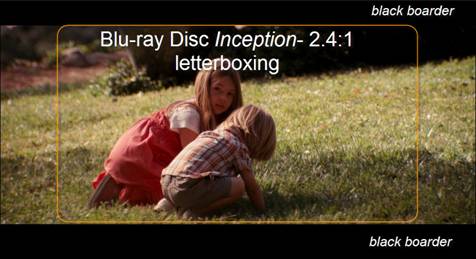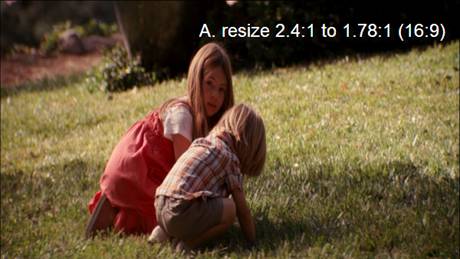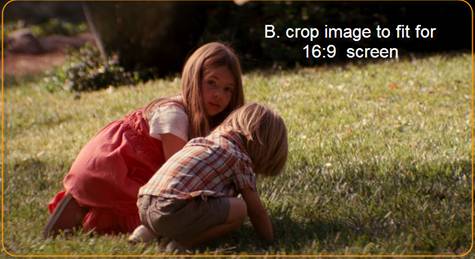Playing anamorphic Blu-ray on 16:9 HDTV: how to get rid of black borders?
When watching Blu-ray movie on a widescreen TV, you may find that the image do not always fits the screen well. Now that most BD movies are released in 2.4:1 aspect ratio, you get bars across the top and bottom of the screen. This is not a big problem with LCD TVs, as they should stay that way because that is how they are meant to be seen. However, it is a problem when you watch these movies with plasma TVs, because you have to use the 16:9 zoom feature because of burn-in issues. This leads to grainy pictures. Is there any way to adjust Blu-ray aspect ratio to fit for different display? Maybe a best way is to rip the Blu-ray movie to HD video of desired aspect ratio for HDTV.
In digital images there is a subtle distinction between the Display Aspect Ratio (the image as displayed) and the Storage Aspect Ratio (the ratio of pixel dimensions). Blu-ray movies adopts 16:9 (1920*1080pix) as storage aspect ratio. The most common display aspect ratios used today in the presentation of films in movie theaters are 1.85:1 and 2.39:1 (which is sometimes rounded up to 2.40:1). Other cinema and video aspect ratios exist, but are used infrequently. As for example, the Blu-ray movie Nine is released in 1.85:1 aspect ratio, another new released Blu-ray Disc Inception is in 2.4:1 aspect ratio. When playing the two Blu-ray Discs with Sony PS3 on 16:9 HDTV, there are black bars on top and bottom of the image:

The letterboxing is negligibly small for a 1.85:1 BD movie Nine, but is obvious for 2.4:1 Inception Blu-ray. The basic problem is that the theatrical widescreen image is long and horizontal but your TV screen is basically square. When viewing a 2.4: 1 picture on 16: 9 screens, over 25% of the screen is filled with black bars. It's the current display technology that makes Scope movies look half their size relative to 1.85 movies, letterboxing them to make the image fit inside the narrower, 16:9 wide, display shape.
In order to play 2.4:1 Blu-ray movie at full frame on 16:9 HDTV without black bars, there are two ways to go: either stretch the image to fit for 16:9 screen or crop the anamorphic picture to 16:9.

A. Resize the 2.4:1 anamorphic image to 1.78:1.
In this way you just omit the OAR (original aspect ratio) and set 1.78:1 storage aspect ratio when ripping Blu-ray Disc to hard drive. The videos get stretched vertically to fill the full screen.
Pros: everything is preserved and the picture takes up the whole screen, without black borders.
Cons: you lose the OAR (original aspect ratio) and the movie is stretched.

B. Crop the 2.4:1 anamorphic image to fit for 16:9 displays.
In this way a portion of the widescreen theatrical image of a film is selected to fill your TV screen. Letterboxed black borders and partial of the image are cropped out across the widescreen film so that the left image will be just right for 16:9 screen (somewhat like pan and scan).
Pros: you get full-screen display of the movie and not lose aspect ratio.
Cons: this results in a loss of more than 25% of the original image.

The Pavtube Blu-ray Ripper software is able to rip Blu-ray Discs up to latest released Eclipse, Toy Story 3, Inception, etc to MKV, AVI, WMV, MP4, TS, MOV formats with flexible features. It meets your requirements for keeping original aspect ratio, cropping 2.4:1 movie to fit for 16:9 screen and altering aspect ratio for HDTV. Click to download a trial of Pavtube Blu-ray Ripper software.
Common aspect ratios using in DVDs and Blu-ray Discs:
1.33 (4:3)
35 mm original silent film ratio, today commonly known in TV and video as 4:3. Also standard ratio for MPEG-2 video compression. This format is still used in many personal video cameras today and has influenced the selection or design of other aspect ratios. It is the standard 16 mm and Super 35mm ratio.
1.78:1 (16:9)
Video widescreen standard, used in high-definition television, one of three ratios specified for MPEG-2 video compression. Also used increasingly in personal video cameras.
1.85:1
35 mm US and UK widescreen standard for theatrical film. Introduced by Universal Pictures in May, 1953. Projects approximately 3 perforations ("perfs") of image space per 4 perf frame; films can be shot in 3-perf to save cost of film stock.
2.35:1
35 mm anamorphic prior to 1970, used by CinemaScope ("'Scope") and early Panavision. The anamorphic standard has subtly changed so that modern anamorphic productions are actually 2.39,[1] but often referred to as 2.35 anyway, due to old convention. (Note that anamorphic refers to the compression of the image on film to maximize an area slightly taller than standard 4-perf Academy aperture, but presents the widest of aspect ratios.)
2.39:1 (2.4:1)
35 mm anamorphic from 1970 onwards. 2.39:1 is sometimes rounded up to 2.40:1[1]. Often commercially branded as Panavision format or 'Scope.
Pavtube Blu-ray Ripper software
 |
 |
 |

